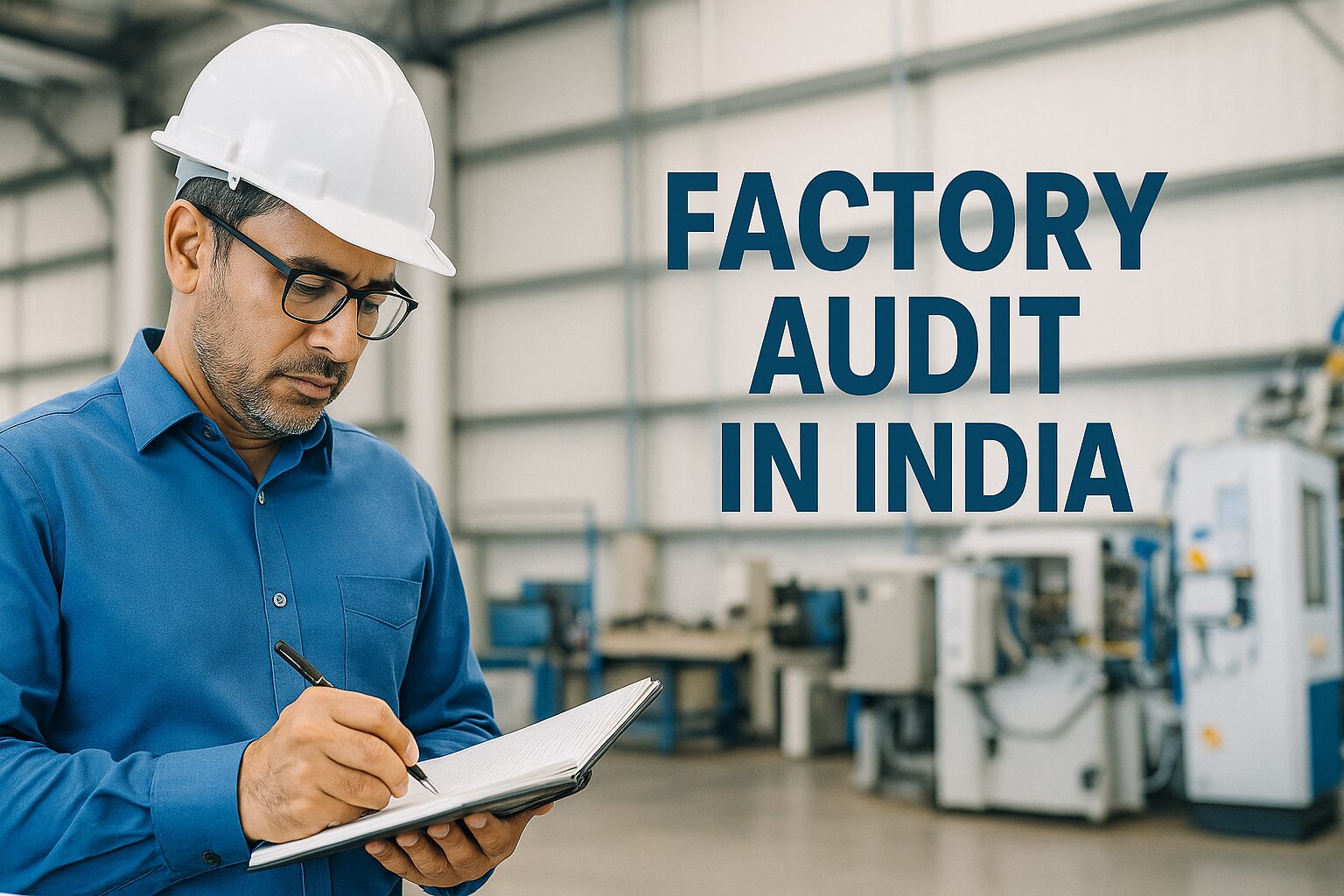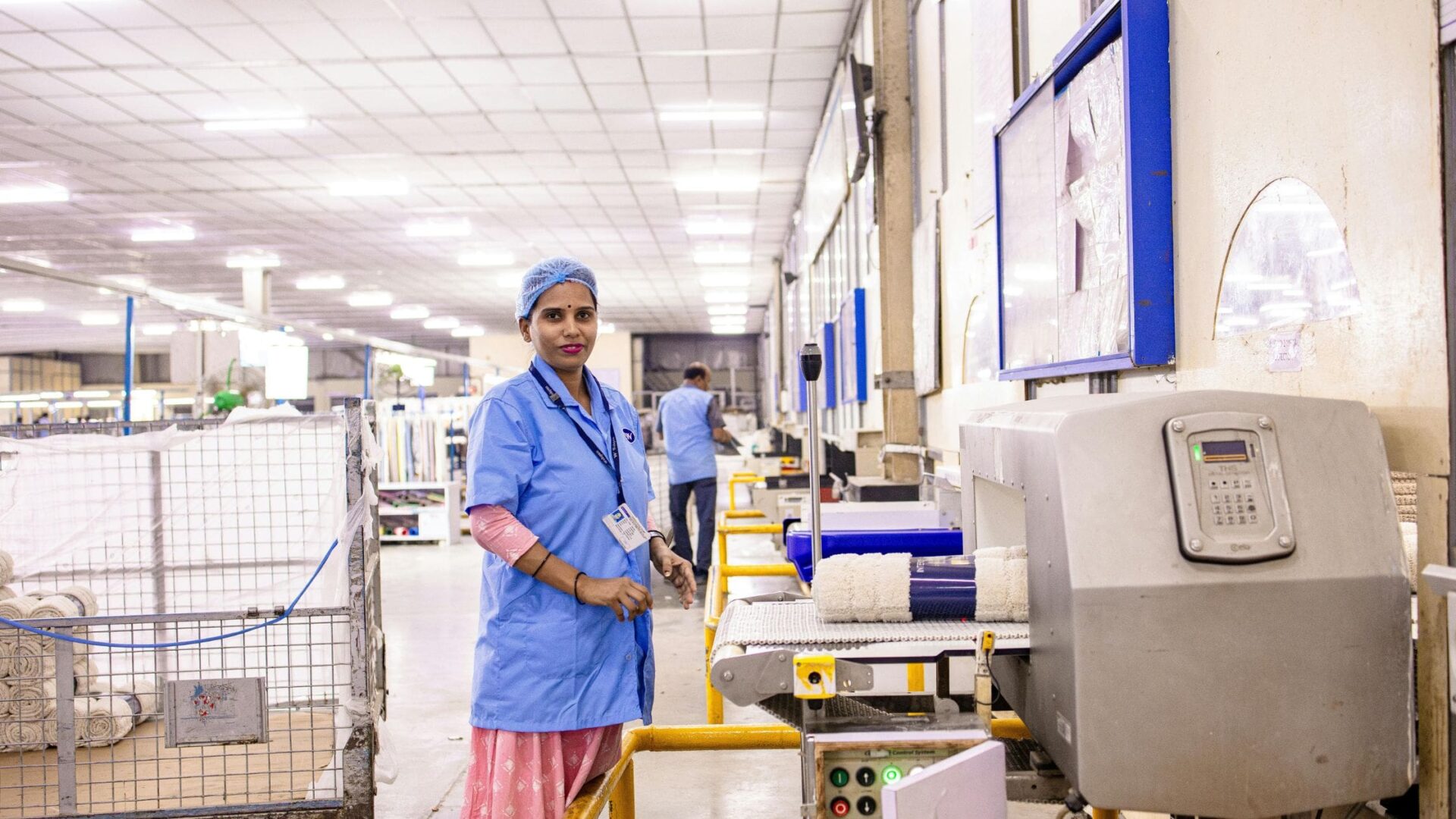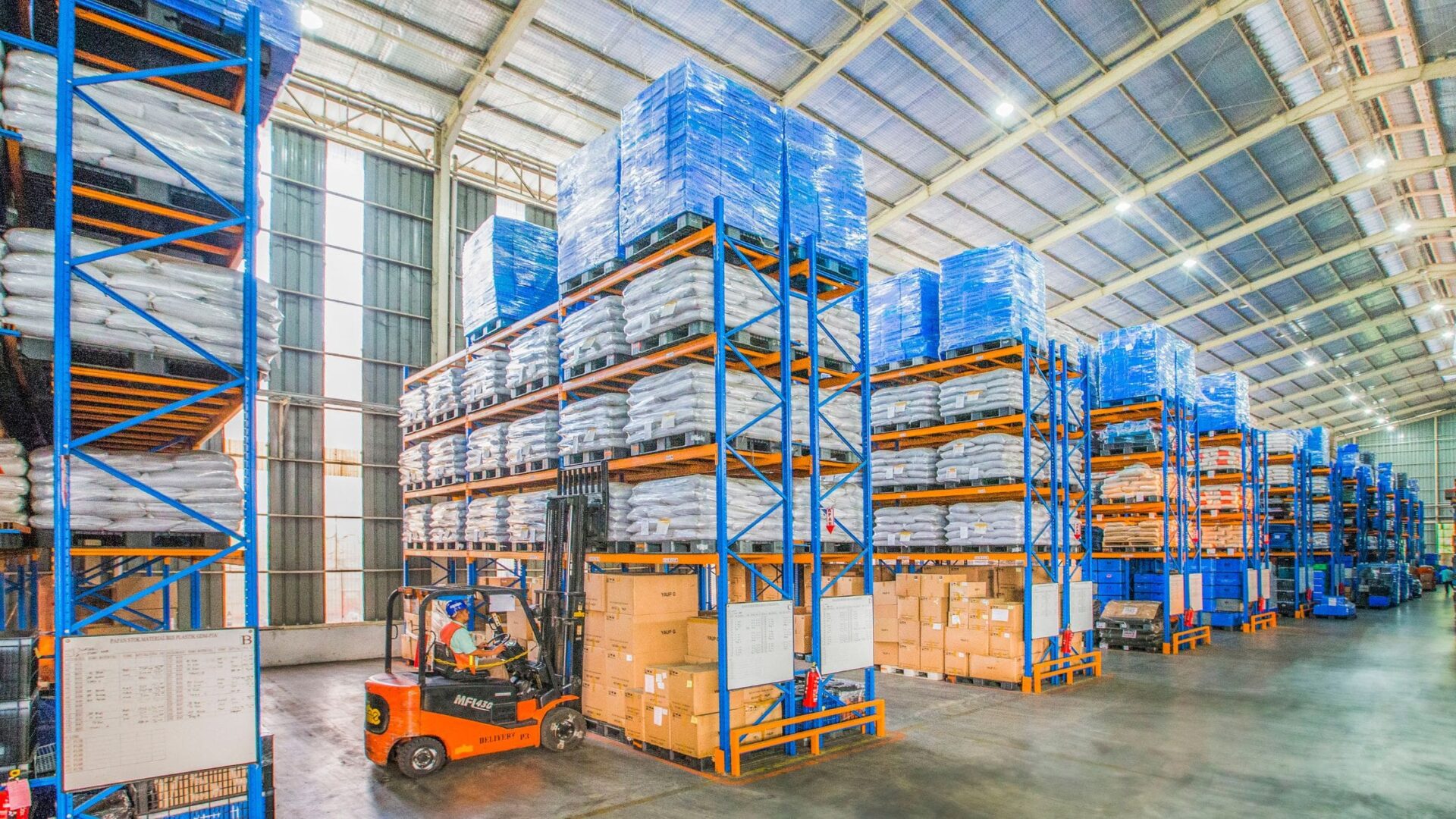Finding the right supplier in India can feel a bit like dating, exciting, full of possibilities, but risky if you don’t really know who you’re dealing with.
That’s why a factory audit in India isn’t just a formality; it’s your chance to truly see behind the curtain before you put money on the table, because one wrong move and your business is buried in legal battles before it even has the chance to kick off ground level.
With India’s manufacturing scene booming across everything from textiles and fashion accessories to electronics and industrial components, more businesses are looking to diversify their supply chains here. The opportunities are huge, but so are the stakes.
An audit in India lets you look beyond a shiny brochure or a well-designed website. You get to see the manufacturer’s real capabilities, the condition of their equipment, the quality control measures in place, and even the working environment for their team.
Unlike a product inspection that checks a single batch, a factory audit digs deeper into systems, processes, and long-term reliability.
So, the big question is, what do you need to know about how these audits work, and why do they matter?
What is a Factory Audit in India?

A factory audit in India is a structured compliance audit that measures a manufacturer’s ability to meet your product quality, safety, and delivery requirements. It goes far beyond inspecting finished goods. Auditors assess manufacturing processes, quality control systems, and adherence to quality standards such as ISO 9001.
They review the factory’s documentation, including ownership records, export licenses, and quality manuals, and evaluate how well quality control procedures are applied on the production line.
Audits in India are typically performed by certified third-party auditors to ensure impartiality, though internal audit teams may be used for ongoing supplier audits or process audits.
The purpose is to validate the facility’s production capacity, infrastructure, and reliability before you commit to a business relationship.
As part of the process, auditors verify whether the operation is a genuine factory or a trading company by checking on-site production lines, staff headcounts by role, and the balance of in-house versus outsourced processes.
This approach helps you reduce risks, confirm compliance, and set clear expectations with your suppliers from the outset.
Now that we have highlighted in detail what a factory audit in India is all about, the next step is to know why exactly they are considered important, and if it really matters.
Why are Factory Audits Important in India?
A factory audit in India is one of the most effective ways to vet a supplier before you commit to an order. It gives you an impartial view of the manufacturer’s quality management systems, production processes, and overall capabilities. By verifying that a factory meets quality standards, maintains proper quality control measures, and complies with regulations, you can avoid costly risks that often remain hidden until production is underway. Every new supplier should be audited, and existing suppliers should be re-audited periodically to ensure their systems, equipment maintenance programs, and production capacity remain reliable.
Audits are also a powerful safeguard against misrepresentation. In one real case, staged cartons were arranged to appear as a complete shipment, but the audit found only 37% of the goods were actually packed, despite an 80% completion claim. Detecting this before shipment prevented financial loss and delays. Beyond fraud prevention, audits reduce the risk of non-compliance in labor, safety, or environmental practices, and they help avoid late deliveries caused by undisclosed capacity limits.
In India, product AQL failure rates have been cited around 30% in market commentary, which highlights the value of identifying weaknesses upstream. When you address them early through a structured factory audit checklist, you improve supplier communication, align expectations, and create a foundation for stronger business relationships built on consistent product quality and trust.
What Does The Factory Audit In India Include?
A factory audit in India follows a structured process designed to evaluate a manufacturer’s capabilities, quality management systems, and compliance with quality standards. It starts with defining the audit objectives and scope, ensuring the review addresses the right production processes and requirements. Auditors then prepare a customized factory audit checklist, mapping each checkpoint to applicable standards and buyer specifications. The audit includes reviewing documentation, inspecting the facility and equipment, interviewing staff, and verifying that quality control measures are in place and effective.
Every step of the auditing process plays a role, and in the following sections we’ll discuss everything a factory audit should include and the steps you need to take prior to starting.
Step 1: Define Audit Objectives And Scope
Your number one move should be to highlight the purpose and boundaries of the audit in India. You need to decide whether your primary focus is on production capability, quality management systems, social compliance, environmental responsibility, or intellectual property security, or a combination of these areas. The scope should be mapped to relevant standards such as ISO 9001 for quality management, local labor and safety regulations, and your own product specifications. Determine whether you require a standard compliance audit, which offers a broad review, or a technical process audit with a deeper focus on specific manufacturing processes. Identify critical steps, such as welding, heat treatment, or SMT assembly, and confirm whether these are performed in-house or outsourced.
Step 2: Prepare Audit Checklists
After you have successfully handled that, create a detailed factory audit checklist tailored to the specific facility, products, and industry. Modular checklists should cover general company information and licenses, infrastructure, machinery and equipment maintenance, production processes, calibration and testing procedures, quality control procedures, nonconformance handling, training, HR and payroll basics, environmental health and safety, warehouse and packaging standards, traceability systems, and IT or security controls. A factory audit typically contains more checkpoints than a basic supplier verification, with additional emphasis on preventive maintenance programs, corrective and preventive actions (CAPA), and internal audit processes. Tailoring is important—electronics manufacturers may require ESD control checks, textile factories may need dyeing effluent management reviews, and metalworking plants might require heat-treatment chart verification. For each checklist item, note the type of evidence required, whether it’s documentation, interviews, visual observation, or photo and video capture.
Step 3: Schedule And Plan The Audit
Once the factory audit objectives and checklist are set, you need to coordinate the schedule and logistics.
This begins with sending a pre-audit pack to the supplier, requesting documents such as the organizational chart, process flow diagrams, production capacity data (lines, shifts, and units per hour), the last 12 months of defect or nonconformance trends, relevant licenses, recent internal audit reports, and training logs.
Confirm whether translation will be necessary to ensure technical requirements are understood and accurately addressed. Consider regional logistics, some factories in India operate in remote clusters, so travel buffers may be needed.
Sharing the factory audit checklist outline in advance helps the manufacturer prepare records and ensures the audit in India proceeds efficiently while covering all agreed quality standards and compliance requirements.
Step 4: Conduct The Audit
The on-site portion of a factory audit in India begins with an opening meeting to confirm the scope, clarify which departments will be sampled, and secure full access to areas and documentation. Auditors then conduct a detailed walkthrough of the facility, including the production floor, incoming materials inspection, in-process and outgoing quality control stations, testing laboratories, warehouses, and packaging areas. If relevant, worker dormitories or canteens are also reviewed. Interviews are held with management to verify systems and with operators to confirm practical controls, while confidential worker interviews assess social compliance. Production capacity is validated by observing cycle times, work-in-progress levels, and preventive maintenance records. Calibration status, NCR/CAPA effectiveness, and adherence to documented quality control procedures are also checked. Legitimacy is confirmed by cross-checking business registrations, export readiness, and whether key manufacturing processes are performed in-house or outsourced.
Step 5: Document Findings And Evidence
During the audit, every finding should be recorded with clear, time-stamped evidence. This includes photos or video clips, document identifiers, the names of interviewees, and sample sizes. Each observation is linked directly to the relevant clause in the factory audit checklist to maintain traceability. Issues are categorized by severity, critical, major, or minor, and tied to specific risks such as quality defects, safety hazards, or regulatory non-compliance. It’s equally important to capture positive practices that demonstrate strong capabilities or adherence to best practices, as these support supplier development and strengthen business relationships. Accurate and well-organized documentation forms the basis of the audit report and ensures that corrective actions can be clearly communicated and verified.
Step 6: Closing Meeting
After completing the on-site review, you hold a closing meeting with factory management to present the preliminary findings. This debrief should summarize both strengths and areas of concern, highlighting prioritized nonconformities that require immediate attention. If urgent containment actions are needed to protect product quality or safety, these should be clearly outlined. Align with the manufacturer on timelines for implementing corrective actions and specify the evidence you expect as proof of completion. Any open items that require additional documentation or clarification should be discussed so there is no misunderstanding. This step ensures that the supplier fully understands the audit in India results and is prepared to address compliance and quality requirements without delay.
Step 7: Audit Report And Corrective Actions
Following the closing meeting, the next step is to prepare a structured audit report that documents the factory audit in India in detail. The report typically includes an executive summary, the overall evaluation score or grade, and a clear breakdown of findings linked to the factory audit checklist. Each issue should be supported with evidence such as photos, document references, and interview notes, along with its potential impact on product quality, compliance, or delivery reliability. Recommendations for improvement should be specific and actionable. You then issue a corrective action plan (CAPA) assigning responsibilities, deadlines, and root cause analysis for each nonconformance. The verification method, whether document submission, on-site re-audit, or both, should be defined. Critical or systemic failures require follow-up audits to confirm that quality control measures, equipment maintenance, and production processes meet the required standards, ensuring ongoing trust and strong supplier relationships.
What are the Different Types of Factory Audits in India?
The most common types of factory audits in India include quality system audits, social compliance audits, environmental audits, security audits, specialized industry audits, process audits, and capability audits. Each serves a distinct purpose in verifying that a supplier can meet your product quality, safety, and compliance requirements. For example, a compliance audit might focus on legal and regulatory adherence, while a process audit examines specific production processes for consistency and reliability. By understanding the scope and purpose of each type, you can select the most relevant approach for your needs. A well-chosen audit helps you evaluate manufacturing processes, assess quality control procedures, and confirm that quality management systems align with recognized standards.
Now, let’s shed more light on the types of factory audits, to ensure you know the required standards your products have to meet.
Quality System Audits
A quality system audit in India focuses on verifying that a factory’s quality management systems meet recognized standards, such as ISO 9001. Auditors review document control processes, records of internal audits, management review procedures, and the handling of nonconformances with corrective and preventive actions (NCR/CAPA). They also check how supplier control is managed, ensuring incoming materials meet specifications. Calibration of equipment is verified to maintain measurement accuracy, and process capability claims are tested against actual controls, such as statistical process control at critical-to-quality points, first-article inspections, and golden sample retention. These audits also examine change control mechanisms and how customer-specific requirements are communicated throughout manufacturing processes.
Social Compliance Audits
A social compliance audit in India assesses whether a manufacturer operates in line with Indian labor laws and global ethical standards. This includes verifying legal working hours, overtime pay, and age documentation to prevent child labor. Auditors inspect worker accommodations, such as dormitories and canteens, to confirm they meet safety and hygiene requirements. They also evaluate the availability and use of personal protective equipment, the execution of safety drills, and the existence of effective grievance mechanisms. Confidential interviews with workers are a critical part of this process, providing insight into issues like discrimination, coercion, or excessive overtime that might not appear in official records. These audits help you ensure that your suppliers maintain a safe and fair working environment, which protects your brand reputation, strengthens long-term business relationships, and supports compliance with both local regulations and international buyer requirements.
Environmental Audits
An environmental audit in India evaluates whether a manufacturer complies with environmental regulations and follows sustainable practices. Auditors check that the facility holds valid permits and maintains accurate emissions and wastewater treatment logs. Hazardous waste manifests are reviewed to ensure proper handling and disposal, along with spill response plans. Energy consumption and water use monitoring are examined to identify efficiency gaps. The audit also verifies the presence and functionality of pollution control technologies, such as scrubbers or effluent treatment plants, and ensures records management is consistent and complete. By including these elements in a factory audit checklist, you can confirm that your supplier’s operations protect the environment while meeting compliance audit requirements, which is increasingly critical for maintaining trust in global supply chains.
Security Audits
A security audit in India focuses on protecting intellectual property, physical assets, and sensitive production data. Auditors review visitor management procedures, verify that restricted areas are properly controlled, and assess CCTV coverage for critical locations such as production lines, warehouses, and R&D areas. Inventory security practices are checked to prevent unauthorized removal of goods or components. IT access controls and data handling procedures for product specifications, bills of materials, and design files are evaluated for adherence to security standards. The audit also validates a supplier’s oversight of subcontractors to prevent IP leakage.
Specialized Industry Audits (e.g., Food & Pharmaceuticals)
Specialized industry audits in India address sector-specific requirements where safety, quality, and compliance standards are particularly strict. In the food sector, audits examine hygiene zoning, allergen control measures, sanitation standard operating procedures, temperature monitoring, packaging integrity, and full traceability from lot or batch to finished goods. For pharmaceuticals and cosmetics, auditors assess compliance with Good Manufacturing Practices (GMP), cleanroom classifications, process validation, sanitation protocols, and documentation integrity following ALCOA+ principles. In electronics manufacturing, audits may include RoHS laboratory testing for restricted substances such as lead, mercury, and cadmium, verification of ESD controls, and component traceability checks.
Process Audits
A process audit in India examines how specific production processes are controlled and executed at the line level. The goal is to ensure that each step of the manufacturing process consistently meets quality standards and delivers the desired product quality. Auditors map process inputs and outputs, review control plans, and verify that operator work instructions are clear and up to date. They assess whether tools, bushings, and jigs are adequate for the production requirements, and check changeover procedures for efficiency and accuracy. Scrap loops and defect handling systems are evaluated to ensure problems are identified and resolved quickly. Layered process audits, conducted at different times and by different levels of management, are often used to verify that procedures are followed during shifts, helping detect non compliance before it affects final products.
Capability Audits
A capability audit focuses on validating a manufacturer’s claimed production capacity and its ability to meet delivery commitments. In a factory audit in India, this involves observing actual cycle times on the production line, reviewing shift patterns, and checking work-in-progress buffers to confirm realistic throughput. Auditors identify bottlenecks that may impact schedules and examine maintenance downtime history to evaluate equipment reliability. Material availability is reviewed to ensure production is not disrupted by supply chain gaps. By comparing observed performance with stated capabilities, you can better assess whether a supplier can meet your order volumes and timelines without risking product quality or delivery reliability. This type of audit is especially useful when you need assurance that the supplier’s facilities, equipment maintenance practices, and workforce capacity align with your business requirements and expectations.
How Should You Follow Up After A Factory Audit In India?
Following a factory audit in India, you should treat the results as a roadmap for improvement rather than a simple checklist. Post-audit monitoring starts with tracking Corrective and Preventive Actions (CAPA) to closure, supported by evidence packs that may include photos, updated standard operating procedures, and maintenance logs. You need to verify that these quality control measures are not just implemented on paper but are actively improving production processes and working environments.
Effectiveness checks, typically performed 30–90 days after implementation, help confirm that the manufacturer has addressed non-compliance and met required quality standards. Using a scoring system to assess audit report findings allows you to determine re-audit cadence. Critical risks often warrant earlier follow-ups. Pairing CAPA with targeted training programs and internal supplier audits ensures that improvements become part of the factory’s daily operations, supporting long-term product quality and supply chain reliability.
How Frequently Should Factory Audits Be Conducted In India?
For most suppliers, factory audits in India should be scheduled at intervals that match their risk level and product complexity. New manufacturers are best audited before a purchase order is placed and again after roughly 6–12 months to confirm consistent adherence to quality control systems and production capacity claims.
In high-risk industries, such as toys or fashion accessories, quarterly or biannual supplier audits are often necessary to maintain compliance with industry regulations and product specifications.
Mature, low-risk factories with strong audit scores may only require annual audits, supplemented by targeted mini-audits if there are significant process changes or a spike in quality issues. When planning audit services, consider the location of the facility, shipping schedules, and seasonal production peaks. Factoring in these elements helps balance efficiency, cost, and the ongoing need for quality assurance across your supply chains.
What Should Be Included in a Factory Audit Checklist?
A detailed factory audit checklist should include areas such as facility safety, equipment maintenance, workforce compliance, production capacity, and adherence to relevant regulations. You also want to review quality control procedures, product inspections, and documentation that supports compliance audit requirements.
This document is not just for the auditors, it is a tool that helps you protect supply chains, prevent non-compliance, and maintain product quality. When applied consistently, it offers a clear view of the factory’s working environment, production line reliability, and readiness to deliver goods that meet your expectations.
Now in the next section, we’ll discuss deeper on what needs to be included in a thorough factory audit checklist, so you don’t miss out on quality and compliance standards.
General Facility Conditions
Assessing the general facility conditions ensures the factory’s infrastructure and working environment are safe, clean, and optimized for reliable production. During a factory audit in India, this review typically covers the structural integrity of the buildings, accessibility of emergency exits, and the presence of functioning firefighting equipment. Lighting and ventilation should support worker health and consistent manufacturing processes, while pest control measures and 5S practices help maintain cleanliness and efficiency.
Auditors often confirm that aisles are clear and evacuation routes are properly marked, which is critical for meeting safety regulations and ISO quality systems. A facility that maintains these standards not only supports quality assurance but also signals the manufacturer’s commitment to sustainable operations. These observations form a vital part of the audit report, influencing decisions about ongoing business relationships and supplier audits. After you are sure that the general facility conditions are up to par, you need to ensure the workforce and labor compliance is in check too.
Workforce And Labor Compliance
Workforce and labor compliance is a core part of a factory audit checklist, ensuring that the manufacturer’s practices meet both local laws and international quality standards. You should verify employee records for legal working age, check that contracts are in the local language, and confirm accurate payroll with proper overtime premiums. Attendance logs and safety training documentation also provide insight into how the factory prioritizes worker welfare.
Inspectors often check whether personal protective equipment (PPE) is issued and maintained, and if first-aid stations are well stocked and accessible. They also look for clear grievance channels to support worker communication and cooperation. Proper labor compliance strengthens a manufacturer’s credibility and ensures that production processes remain sustainable and ethical..
Sorting out the workforce and labor compliance obviously influences audit services, so next we’ll look at the role production capability and processes play.
Production Capability and Processes
When evaluating a factory’s production capability, you should verify the machinery inventory, including equipment lists with serial numbers and calibration status. Reliable equipment maintenance records and preventive maintenance history show whether production capacity can be sustained without unexpected downtime. Process controls, such as takt time alignment, help you determine if the manufacturing processes can consistently meet your order volume and product specifications.
You also want to map the process flow from raw materials to finished goods. This helps identify bottlenecks, areas of waste, and points where quality control systems should be strengthened. Inspectors may review spare parts availability, security measures for high-value components, and how the factory addresses potential risks during production. By combining technical inspections with a review of operational practices, you get a clearer picture of the factory’s capabilities, the reliability of its production line, and whether it can fulfill your expectations without compromising on quality.
Quality Management Systems
Quality management systems form the backbone of any manufacturer’s ability to deliver consistent products that meet required quality standards. During the audit, you should review document control procedures to ensure that inspection and test plans are properly maintained and accessible to relevant team members. Inspectors often look for adherence to sampling procedures, such as acceptable quality limits (AQL), and whether laboratory testing capabilities are sufficient for the range of goods being produced.
Another critical step is checking how the factory manages nonconforming products. This includes containment, segregation, and corrective actions to prevent recurrence. Internal audits, management reviews, and certification to recognized standards like ISO are signs of a mature quality assurance program. Strong quality control procedures not only reduce the risk of defects but also strengthen your trust in the supplier’s long-term reliability. The next on the list after your quality management systems are in place is the supply chain and raw material control.
Supply Chain and Raw Material Control
Raw material control is a must if you intend to only receive products that match the promised specifications. An effective compliance audit will verify the factory’s approved vendor list, ensuring suppliers meet the same quality control measures and certification requirements expected for your goods. This step protects against risks from unreliable sources that could compromise your supply chains.
Incoming quality control (QC) inspections should be documented, including certificates of analysis (COAs) from vendors. Lot and batch traceability from raw materials to finished goods is essential for product inspections and any required recalls. You should also confirm that the facility uses proper segregation and quarantine practices for noncompliant materials. By maintaining rigorous supply chain controls, the manufacturer safeguards your business relationships, reduces potential production issues, and ensures the end products meet your quality expectations consistently.
Who is Conducting the Factory Audit in India?
Ideally, a factory audit in India is conducted by one of three groups: your internal audit team, an independent third-party auditor, or the customer’s own audit team.
Internal teams give you more control and continuity, as they already know your products, quality systems, and manufacturing processes.
However, they may face conflicts of interest or lack the bandwidth to visit multiple facilities across India’s manufacturing hubs. Independent auditors bring impartiality, standardized methods, and sector-specific experience, which reduces risks of non-compliance and ensures quality standards are met.
They often have local inspectors familiar with Indian regulations, EHS requirements, and regional languages. Customer-led audits can be fast and focused but may be narrow in scope. The most reliable audit services include photo-rich audit reports, severity-coded findings, and CAPA templates.
After figuring out who you need to conduct your factory audit, the next thing you need to consider is when it’s necessary to choose the option of a third-party auditor, and the next section will answer this.
When Should You Consider Third-Party Factory Audits in India?
Third-party audit services are especially valuable when you are onboarding a new supplier, sourcing high-risk commodities, or operating in regions where your team has limited access. Independent auditors help you meet global quality standards while avoiding conflicts of interest.
They can inspect factories anywhere in India, provide translator support, and even mediate cultural differences during the audit process. If your business needs consistent reporting across multiple suppliers, these auditors can benchmark production processes and quality control systems for better comparisons.
When internal teams cannot travel, third-party auditors ensure your products meet the required specifications, improving both trust and compliance in your supply chains.
So what next? Choosing the right auditor, as this is the pillar of how your audits turn out. Let’s get into it.
How to Choose the Right Auditor in India?
You can choose between internal audits for control and familiarity, or third-party auditors for impartiality and wider coverage. When hiring, look for credentials in quality management systems, experience in your product category, and knowledge of Indian regulations.
Strong auditors understand ISO standards, statistical sampling, and quality control procedures while offering proven checklists for your industry. Compare quotes not just by day rate but by scope, time on-site, reporting turnaround, and re-audit policies. Ask to review anonymized sample reports to check for detailed evidence and scoring clarity.
Qcadvisor operates with its own in-house teams in India, directly managing inspections, factory audits, and supplier evaluations in major hubs such as Delhi NCR, Mumbai, Pune, Bengaluru, Chennai, and Ahmedabad.
Alongside these core factory audit services, we work with long-term trusted partners across other manufacturing regions to ensure consistent, high-quality audit results.
What Tools and Technologies Can Improve Factory Audits in India?
Improving the efficiency and accuracy of a factory audit in India often comes down to the tools and technologies you choose. Modern audit services now rely on mobile audit apps that work even offline, capturing time-stamped and GPS-tagged photos. These tools let you link each piece of evidence directly to a clause in your factory audit checklist, ensuring nothing is missed during the process audit.
For low-risk scopes, remote or hybrid audits are gaining traction. Secure video conferencing, live production line walkthroughs, and shared document portals cut down on travel costs without sacrificing visibility into the manufacturer’s working environment. AI-powered checklists go a step further, spotting anomalies in logs, ensuring full coverage of requirements, and automating corrective action tracking.
Integrating AQL calculators, barcode or QR-based traceability, and e-signatures creates a stronger data trail for audit reports.
Is It Expensive to Do Factory Audits in India?
The cost of a factory audit in India varies depending on several factors. For one, location plays a big role as audits in metro areas tend to be less expensive than those in remote manufacturing clusters. Other cost drivers include translator services, the type of audit (whether it’s a social compliance audit, GMP review, or technical deep dive), and the number of days auditors spend on-site reviewing manufacturing processes and quality control systems.
Market reference points can guide your expectations. Early or in-process product inspections may run around USD $149 per man-day, while final random inspections average closer to USD $259 per man-day. Comprehensive factory audits often require 1–2 man-days or more depending on scope and complexity.
You should also account for lab testing, such as RoHS compliance, re-audits to address critical non compliance issues, and verification of corrective actions..
What are the Common Challenges When Sourcing and Conducting Factory Audits in India And How to Avoid Them?
When conducting factory audits in India, you might face difficulties with communication, navigating regional differences in manufacturing processes, or managing the travel needed to reach facilities. These factors can affect the accuracy of the audit report, the evaluation of product quality, and the review of quality control systems.
Many companies also underestimate the complexity of assessing production processes across different regions and industries. Without proper planning, you risk missing key aspects of compliance audits or overlooking potential non compliance in quality control measures. By preparing clear documentation, confirming requirements with the supplier, and choosing auditors with local expertise, you can improve the reliability of the findings. The next few sections will shed more light on these problems and effective ways to bypass them.
Language And Cultural Barriers
One of the most common issues during a factory audit in India is miscommunication. Even when a manufacturer provides bilingual staff, you can encounter gaps in understanding complex quality management systems or technical product specifications. If the translation is incomplete, you risk misinterpreting compliance requirements or misaligning production line procedures with your intended quality assurance goals.
To avoid these problems, arrange for a professional translator who understands manufacturing processes and audit terminology. Use visuals such as flowcharts, diagrams, or photographs to illustrate requirements and clarify product inspections. During the audit in India, confirm shared understanding by rephrasing key agreements and recording them in the audit report. ensure both you and the supplier adhere to the same quality control procedures and quality standards.
Geographic Spread Of Factories
India’s manufacturing industry is diverse, with production clusters spread across the north, west, south, and east regions. If your supplier audits involve multiple factories in remote areas, travel logistics can become a major factor. Long transit times between facilities may shorten the actual time auditors spend reviewing equipment, production capacity, and quality control systems. This can lead to incomplete evaluation of the working environment or production processes.
You can improve efficiency by planning routes that allow inspectors to cover multiple sites in a logical sequence. Build in buffer days for unexpected delays, such as local holidays or transport disruptions, which could affect the audit’s results. Understanding the geographic spread also helps you allocate budget more accurately, especially when additional days on-site increase overall audit costs. By addressing these logistical concerns early, you reduce the risk of rushed inspections and ensure your compliance audit meets both operational needs and quality expectations.
Documentation and Transparency Issues
When arranging a factory audit in India, you may encounter documentation gaps that affect the accuracy of the audit report and your confidence in the supplier’s quality management systems. It’s common to find incomplete training logs, missing equipment maintenance histories, or limited disclosure about subcontractors involved in manufacturing processes. These gaps can create risks for compliance and make it harder to confirm that quality control measures align with your requirements. To reduce these issues, specify the exact records needed in a pre-audit pack before the audit in India begins. During the inspection, use triangulation by cross-checking interviews, direct observations on the production line, and records in the factory audit checklist. This approach helps detect non compliance, such as staged goods or idle machinery presented as active.
What are the Risks of Skipping Factory Audits in India?
Without proper inspection, you may fall victim to supplier misrepresentation, for example, a manufacturer claiming that 80% of an order is complete when only about 37% is actually packed. Skipping audit services also increases the likelihood of undisclosed subcontracting, counterfeit certifications, and non compliance with quality standards or safety regulations.
Poor quality control measures often lead to higher AQL failure rates, rework, production delays, or costly returns. In addition, legal or environmental, health, and safety violations can trigger shipment holds, fines, or reputational harm. A comprehensive compliance audit using a detailed factory audit checklist provides the documentation and assurance you need to verify manufacturing processes, confirm adherence to quality management systems, and safeguard against these preventable problems.
How Do Factory Audits in India Compare to Other Countries?
Conducting a factory audit in India presents unique challenges compared to similar processes in countries like China or Vietnam. Supplier audits here often require more on-site verification because supplier discovery relies less on online directories and more on trade fairs or industry associations. This means you’ll need direct contact with manufacturers to assess production processes, quality control systems, and working environments.
India’s geographic spread can complicate logistics, with facilities located far from one another, unlike some single-hub manufacturing regions. Audit services must also account for a complex regulatory framework, where both central and state-level standards influence compliance audit requirements. This creates a need for localized quality control procedures and tailored audit checklists.
What Regulations Govern Factory Audits in India?
Auditors typically use a factory audit checklist that aligns with Indian laws and international quality management systems, such as ISO standards. This approach helps assess whether manufacturing processes, working environments, and equipment maintenance meet the required benchmarks. In addition to verifying quality control procedures, a thorough process audit evaluates documentation, production capacity, and safety practices.
Regulatory adherence in India is enforced through a combination of central government acts and state-specific policies, which makes local expertise and detailed audit reports critical. These rules include environmental compliance, labor and social compliance, industry specific compliance, government initiative and export standards, and ethical and safety standard references.
Environmental Compliance Standards
Environmental compliance is a major component of any factory audit in India. Under the Environment Protection Act, 1986, manufacturers must control air, water, and noise pollution, maintain waste disposal records, and use approved pollution control technologies. These requirements are directly linked to the sustainability of production processes and the long-term reliability of your supply chains.
The National Green Tribunal (NGT) plays a critical role in overseeing compliance. Through targeted inspections and audit services, it reviews waste management systems, hazardous material handling, and energy efficiency measures. If non-compliance is detected, penalties or mandated corrective actions can significantly disrupt operations.
For you as a client, ensuring your supplier meets these environmental requirements is essential. It not only safeguards your brand reputation but also ensures that products, from lighting components to fashion accessories, are made within an environmentally responsible framework.
After making sure your project is compliant with the environmental stands, you need to check your box on labor and social compliance regulations as well. Keep reading.
Labor and Social Compliance Regulations
Labor compliance is equally vital in a factory audit in India. The Factories Act, 1948, sets the foundation for worker safety, health, and welfare. It regulates working hours, rest breaks, ventilation, and the safe handling of machinery, directly influencing the quality control systems and working environment in a facility. Auditors often verify adherence to these standards during process audits to ensure both worker safety and production reliability.
The Industrial Employment Act, 1946, complements these protections by defining fair labor practices, wages, grievance procedures, and employment terms. This documentation is not just a legal requirement; it’s an essential part of a compliance audit that safeguards your business relationships and prevents disputes.
When supplier audits address both labor and environmental regulations, you gain a complete view of a manufacturer’s capabilities and risk profile. Meeting these social compliance requirements builds legitimacy, supports ethical manufacturing, and ensures that your products, whether toys, packaging, or industrial components, are produced under conditions that align with your company’s values and the expectations of your customers.
Industry-Specific Regulatory Compliance
Specialized sectors in India follow strict compliance frameworks that shape how audit services are performed. In food manufacturing, the Food Safety and Standards Authority of India (FSSAI) enforces hygiene, storage, and packaging rules. These audits check that production processes prevent contamination, control preservatives, and meet product specifications that protect consumer health.
In pharmaceuticals and cosmetics, the Drugs and Cosmetics Act, 1940, governs quality control systems, sanitation, raw material sourcing, and equipment maintenance. This process audit ensures products meet strict quality standards and remain safe for end users.
For electronics manufacturing, supplier audits may require RoHS testing to verify products are free from restricted hazardous substances. These checks protect both customers and international market access..
Government Initiatives and Export Standards
India’s national programs also influence how a factory audit in India is conducted, especially for companies aiming to supply global markets. Initiatives like Make in India and Atmanirbhar Bharat encourage local production and higher quality standards, with audits verifying adherence to product specifications, quality systems, and sustainable manufacturing practices.
The Production Linked Incentive (PLI) Scheme adds another layer, providing financial support to industries like electronics, textiles, and pharmaceuticals. Audit services under this scheme confirm that manufacturers meet compliance criteria, uphold worker welfare, and follow environmental policies. For exporters, aligning manufacturing processes with international quality management systems and ISO requirements is essential to passing both domestic and overseas inspections.
Ethical and Safety Standards References
Beyond sector-specific regulations, a comprehensive compliance audit may include internationally recognized ethical and safety frameworks. For example, SMETA methodology addresses labor practices, health, safety, and environmental responsibility within the working environment. Similarly, ISO 45001 provides a structured approach to occupational health and safety management, ensuring processes protect workers and maintain production capacity.
Integrating these frameworks into your supplier audits adds an extra layer of quality assurance. They help verify that manufacturers meet not only statutory requirements but also global best practices. This approach supports stronger partnerships, enhances the legitimacy of your suppliers, and ensures your audit report reflects both regulatory adherence and ethical manufacturing standards.
What Role Do Factory Audits Play in ESG and Sustainability Goals?
Audits generate verifiable data on energy and water use, waste management, labor practices, and workplace safety. This information feeds directly into ESG reporting, giving companies the documentation they need to meet investor expectations and build trust with global customers.
When auditors assess manufacturing processes, working environment conditions, and quality control systems, they also identify areas for environmental improvement. Findings might lead to upgrading effluent treatment equipment, enhancing waste segregation, or improving worker welfare facilities. These steps don’t just strengthen compliance; they also enhance long-term production reliability and brand reputation.
By including ESG-related criteria in your factory audit checklist, you create a process audit that supports both quality assurance and sustainable manufacturing practices. The result is a supplier audit that aligns business relationships with measurable sustainability goals while maintaining high product quality.
How Does Production Inspection in India Complement Factory Audits?
Once you know a facility meets your quality standards, production inspections help ensure that every order maintains that level of performance. The sequence is important: you audit first to assess manufacturing processes, production capacity, and quality control measures, then schedule inspections at key production stages to monitor output and reduce risks.
Common stages include:
- Initial Production Inspection (IPI): Conducted before production starts or at about 10–20% completion. This early step detects risks such as substandard materials or incorrect processes. Typical cost: around USD $149 per man-day.
- During Production Inspection (DUPRO): Performed at roughly 50–60% completion to verify adherence to specifications, schedule, and quality control procedures. Similar cost to IPI.
- Final Random Inspection (FRI): Conducted when goods are 100% finished and at least 80% packed. This is your last checkpoint before shipment, costing about USD $259 per man-day.
How To Find And Pre-Verify Suppliers In India Before Auditing
To find and pre-verify suppliers you need to start by using multiple sourcing channels. Industry directories, export-promotion events, and domestic trade fairs give you access to manufacturers across various industries, from toys and fashion accessories to lighting and industrial components. Supplier membership in recognized sector associations can be a strong signal of experience, adherence to quality standards, and readiness to work with international clients.
Some manufacturers in India may have limited online visibility, so relying on website information alone can miss qualified candidates. You should request documentation on manufacturing processes, quality control systems, and relevant certifications as part of a pre-verification step. Where possible, send auditors or trusted contacts to conduct on-site verification before you commit to an audit in India. This allows you to confirm that the facility, working environment, and equipment maintenance practices align with your requirements, reducing risks of non compliance later in the audit process.
Conclusion
Now you already know that the fastest and most reliable way to build a solid connection with your suppliers and keep everything running ahead of your competitors is by starting with a solid factory audit.
Think of it as laying the groundwork. You’re not only checking manufacturing processes, quality control measures, and compliance with standards before production starts, you’re also setting the tone for how you and your partner will work together.
From there, inspections become your safety net, making sure any improvements found during the audit don’t fade once production is in full swing. The audit report should be more than a score, it’s your playbook for growth. Use it to guide Corrective and Preventive Actions (CAPA), keep re-audits on the calendar, and follow through on changes. When you do, you’re not just reducing risks; you’re building stronger supply chains and making sure your customers get exactly what they expect, every single time without compromise.








